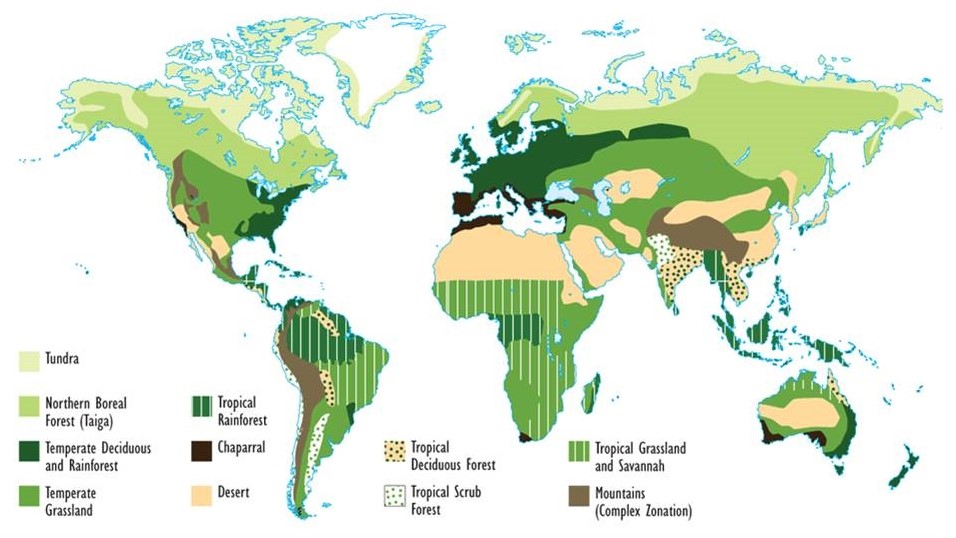Biomes and Agriculture
1. Biomes & Agriculture -Lesson 1: Biomes of the World
The biosphere is the sum of all the Earth's ecosystems and encompasses all living and non-living things on Earth, so includes rocks, water, air, plants, animals, soil and waste and dead remains of what has lived on Earth.
What is the biosphere? (5 mins)
Ecosystems are a community of many living things and their non-living environment. The sizes of ecosystems can vary. Do you have a fishpond in your backyard? That could be an ecosystem, just as the Great Stony Desert can be an ecosystem.
Biomes are very large terrestrial ecosystems that are made up of specific vegetation types and the fauna that specifically lives within that vegetation. The main difference between biomes and ecosystems is the size and scale: biomes are very
large areas, while ecosystems vary in size.
All the elements of a biome exist in some inter-related and inter-dependent relationship. This means that a change in one aspect of the biome (say the extinction of an animal species) will impact and change the rest of the biome. Climate is a major
factor affecting ecosystems. Climate influences vegetation and soils. Consider the lack of vegetation of the tundra and its shorter growing height compared with the tall, lush growth of tropical rainforest. Likewise, the soils in places that have
reliable rainfall over the course of a year are more fertile than those in the desert, where evaporation is greater than precipitation, the water moves in an upward motion through the soil. This results in bringing minerals and salts to the
surface, rather than drawing them down into the soil and leaching through beneath the layers of the soil.
Ecologist Eugene Odum is credited with developing an ecosystems approach to biology. Following from his work, ecosystems and biomes have been classified in a range of different ways. Depending on which text or map you examine the classification
of these biomes may differ, however, generally the classifications used are based on the dominant vegetation type of the area.
Please note: You can have aquatic (water based) biomes but our focus here is on the terrestrial (land based) biomes.
One modification from Odum's classification of biomes includes twelve different biomes:

Tropical Rainforests
As seen in the map above, tropical rainforests are generally located in the Equatorial region, between the Tropic of Cancer and the Tropic of Capricorn. They tend to have very hot temperatures and high rainfall (commonly more than 1500mm per annum). These
are areas that don't tend to have a distinct dry season, receiving some rainfall all year 'round.
Deserts
In stark contrast to Tropical Rainforests, deserts receive very little annual rainfall (usually less than 250mm per annum). There are both hot deserts (like the Sahara Desert in Africa) and cold deserts (like Antarctica), however, the focus of most information tends to be on hot deserts. You will see from the map above that most deserts are far inland, so the temperature is higher in these areas during the day but can be very cold at night. It is a myth to think that nothing grows in the desert. There is some vegetation, but often it has stunted growth. This is due to both the climate and the poor soils in these areas.
Tundra
What do you know about the tundra biome? Consider that first and then watch this video (3:45 mins):
The region from the Arctic Circle to the North Pole is considered to be Tundra. This is like a cold desert, with little rainfall, poor soil and very low temperatures making the growth of much vegetation challenging. Yet, it is thought that there are nearly 2,000 different plant species that grow in these conditions, including a range of mosses and lichens and also some flowers, among others. This is a biome founded on permafrost: a layer of the soil that is permanently frozen.
Grasslands
These areas are relatively dry parts of our world and, as the map above indicates, are divided into temperate grasslands and savanna grasslands. Temperate grasslands tend to have hot summers but cold winters and the rainfall is moderate and seasonal (so not all year 'round). Savanna grasslands are found in parts of Australia and Africa where the summers are relatively hot with high rainfall and the winters are warm and dry.
Biomes in Australia
Can you identify and describe the biomes of Australia? This video will help if you aren't sure (9:20 mins):
Looking for Further Information?
Blue Planet Biomes has a lot of information on different biomes around the world:
https://blueplanetbiomes.org/index.php
Information on Tropical Rainforests (10 mins):
Information on Deserts (15 mins):
Information on the Grasslands Biome (10:50 mins):